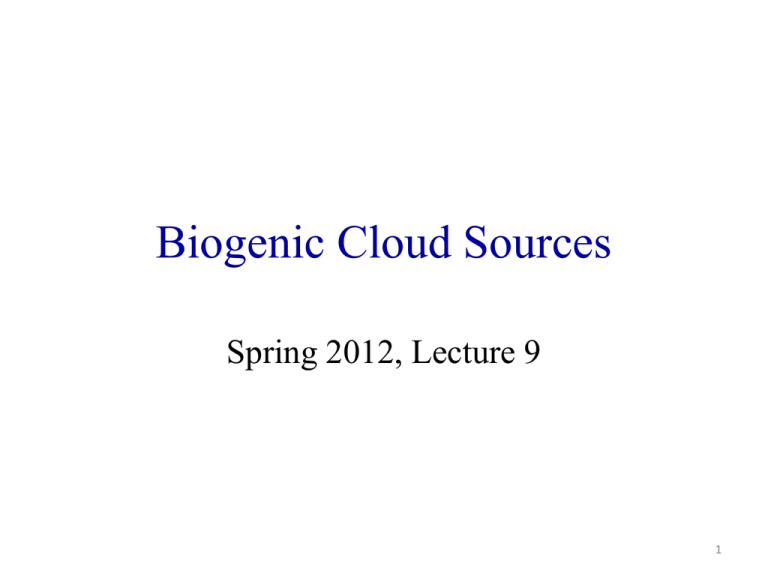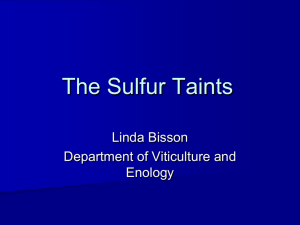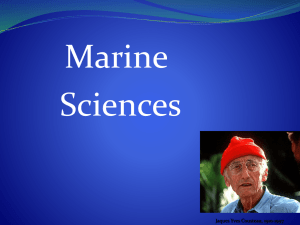Biogenic_Cloud_Sources
advertisement

Biogenic Cloud Sources Spring 2012, Lecture 9 1 Alternative Cloud Formation Method • In the previous lecture, we saw various ways in which clouds could form • There is another way clouds form, and it may be part of a cybernetic system 2 Sulfur Cycle • Sulfur is carried to the ocean as dissolved sulfate ion • Sulfur must be returned from the ocean, if the land is not to be depleted of sulfur • Traditionally, it has been stated that hydrogen sulfide gas is emitted from the ocean • Hydrogen sulfide is familiar to many people as the smell of a rotten egg 3 Hydrogen Sulfide • Hydrogen sulfide stinks and is quite poisonous • If the oceans were emitting large quantities of this gas, we would smell it and travel on the oceans might be hazardous • It is quickly oxidized to sulfur dioxide in the presence of oxygen, and is unstable in the air • It is quite soluble, and should be washed out of the atmosphere quickly • It probably would not have time to be carried over the land 4 James Lovelock • James Lovelock, geophysiologist and creator of the GAIA hypothesis, concludes that hydrogen sulfide cannot be the agent for the return of sulfur to the land • Instead, Lovelock believes that dimethyl sulfide ((CH3)2S), emitted by many marine organisms, might be the carrier gas 5 Dimethyl Sulfide • Dimethyl sulfide, unlike hydrogen sulfide, has a pleasant odor when dilute, and that the smell of the sea, or of fresh caught marine fish, is partly that of dimethyl sulfide • Dimethyl sulfide (DMS) is a naturally produced biogenic gas essential for the Earth's biogeochemical cycles • Certain species of phytoplankton, microscopic algae in the upper ocean, synthesize the molecule dimethylsulfoniopropionate (DMSP) which is the precursor to DMS 6 DMSP Decomposition Note the positive charge on the sulfur, and the negative charge on the proprionic acid part of the DMSP molecule • DMS Molecule 7 Dimethyl Sulfide Decomposition • Dimethyl sulfide decomposes slowly to yield sulfate and methane sulfonate • Both compounds can undergo further oxidation to yield sulfuric acid (H2SO4) and methane sulfonic acid (CH3SO3H) • Rainfall can remove these compounds and deposit them on the ground, but this cycle takes considerably longer than the breakdown of hydrogen sulfide, thus allowing sulfur to return to the land 8 Lovelock and DMS • Lovelock's own work has contributed one clue about dimethyl sulfide • Lovelock traveled on the research vessel Shackleton on a voyage from Wales to Montevideo, Uruguay • Using a gas chromatograph he measured dimethylsulfide, carbon disulfide, and halocarbon gases • He arranged for colleagues to continue this work after he left the ship 9 Marine Deserts • Later, M. O. Andreae made extensive measurements of dimethyl sulfide over the oceans • These measurements confirmed the ability of dimethyl sulfide to be the major carrier of sulfur from ocean to land • The vast ‟desert” areas, characterized by low biological productivity, are particularly large generators of dimethyl sulfide, and they cover about 40% of the earth's surface 10 Satellite Data • The base of the ocean food web consists of abundant and productive phytoplankton • Phytoplankton are tiny ocean plants that convert carbon dioxide to organic carbon, and whose green chlorophyll is visible from space • Satellites can detect this chlorophyll • Satellite data can be used to estimate ocean productivity, and thus detect marine deserts 11 Where are Marine Deserts? • Satellite image showing areas of high biologic productivity in the ocean (green) and low productivity (blue) – these are marine deserts 12 Biological Productivity in Marine Deserts • • • • • Lack of biological productivity is due to lack of nutrients These areas are not devoid of life One example is the Sargasso Sea Such areas are known to have floating strands of seaweed The seaweed strands correspond to the sparse sagebrush, creosote bush, and other plants of the terrestrial deserts • In support of Lovelock’s contention that DMS is the important carrier gas for sulfur, Yoch (2002) provides a table comparing emission amounts of several organosulfur compounds (next slide) 13 Global Emissions of Organosulfur Compounds 14 Magnitude of DMS Emissions • The magnitude of the marine DMS emissions is remarkable, considering that over half of the DMSP released is demethylated and that a significant fraction of the DMS is oxidized by bacteria in the water column before it can be released to the atmosphere • Generation of dimethyl sulfide by marine algae may thus be important for land organisms, because sulfur is scarce on land, but seems fortunate and not related to climate control 15 Benefit to Phytoplankton • Why do phytoplankton generate dimethylsulfoniopropionate (DMSP)? • In what way does it benefit them? 16 Battling Salt • Most marine organisms fight a constant battle with salt • Any desiccation of a marine organism that raises the NaCl concentration is potentially fatal 17 Function of DMSP • Marine phytoplankton generate a compound called dimethylsulfoniopropionate (DMSP). • This compound is known as a betaine, because it is similar to the compound trimethylammonio acetate, or betaine • Although the exact function of DMSP is unclear, it has possible roles in osmoprotection and cryoprotection 18 Betaine • Betaine was first isolated from beets • Beets are known to have a high salt tolerance. Betaines may convey this salt tolerance, possibly by complexing the salt ions 19 Nitrogen or Sulfur? • Other, yet unknown, functions for dimethylsulfoniopropionate may exist • It seems reasonable that terrestrial plants would use a nitrogen betaine, because nitrogen is plentiful on land, and that marine organisms would use a sulfur betaine because of the abundance of sulfur in the sea 20 Benefit of Sulfur Transfer to Land? • Algae that generate dimethylsulfoniopropionate, whatever its role, are a source of dimethyl sulfide • Algae decompose after dying or being eaten • The resulting products include acrylic acid ion and dimethyl sulfide • Lovelock argues those marine algae, working in their own best interest, have contributed a mechanism for the transfer of sulfur to land 21 Decomposition of Rocks into Soil • Sulfur on land would enhance the growth of land plants, which in turn speed the decomposition of rocks into soil • Such decomposition would enhance the flow of nutrients into the ocean, to the benefit of marine organisms • Thus a symbiotic relationship (one beneficial to both partners) develops at a distance, and without conscious thought 22 Marine Deserts and DMS • The generation of dimethyl sulfide may be purposeful rather than fortuitous, but it still does not appear related to the climate • The major generation area for dimethyl sulfide, the marine deserts, may provide a clue 23 Oxidation of DMS • Meteorologists Robert Charlson and Stephan Warren argue that the rapid oxidation of dimethyl sulfide could provide small droplets of sulfuric acid over the ocean • Sulfuric acid is powerfully hygroscopic and could yield the necessary condensation nuclei to produce clouds • Methane sulfonic acid can serve the same purpose 24 Development of Condensation Nuclei • Areas far removed from the continents have few condensation nuclei • Condensation nuclei are often derived from airborne dust generated on the continents o Thus, these areas are expected to generate few clouds o If increased dimethyl sulfide production were to generate large scale cloud cover over what is generally a dark blue ocean, the albedo would change 25 Albedo Effect • Andreae, Charlson, Lovelock, and Warren have calculated the probable effect on the climate • They find that the increased albedo is comparable in magnitude but opposite in sign to the greenhouse effect • Could this be part of a climate regulatory system? 26 Slow vs. Rapid Oxidation • It was previously argued that the oxidation of dimethyl sulfide was slow, thus allowing sulfur to reach the interior of the continents • Yet the argument for increased cloud cover requires the rapid oxidation of dimethyl sulfide • How is this possible? 27 Kinetic Barrier • We have previously seen that the rate of reaction is a kinetic process, involving an energy barrier • The easiest way to speed up a slow reaction is to introduce a catalyst 28 What is the Catalyst? • It is known that iodine compounds catalyze the oxidation of dimethyl sulfide in marine environments • If we can find a source of iodine compounds, we might have a regulatory mechanism • Lovelock suggests that another betaine, methyliodonio propionate, might exist in large algae such as brown seaweed, Laminaria 29 Laminaria digitata • Large, flexible plants with a rubbery texture - Size can range from less than one meter to ten meters or more for L. saccharina or L. longicruris • Color ranges from light brown to dark brown 30 • Source of methyl iodide Iodide Catalysis • Methyl iodide released by sea plants is an important part of the iodide cycle, transferring iodine to the land • Methyl iodide produced by the plants could also serve to form iodine compounds, capable of oxidizing dimethyl sulfide to sulfuric acid • This could trigger cloud formation over the ocean 31 Benefits of Marine Clouds - 1 • Cloud formation can trigger an increase in wind velocity • The mixing of surface waters increases • This brings nutrients from waters below the photosynthetic layer upward, where they can be utilized by the marine algae 32 Benefits of Marine Clouds - 2 • In addition the clouds will probably result in increased atmospheric precipitation • This may wash aerosol dust out of the air into the ocean • In areas where sufficient terrestrial aerosol dust exists, this would provide an additional source of nutrients, particularly scarce nitrogen, to the marine algae 33 Potential Future Benefit • Clouds also filter radiation reaching the ocean surface • In particular, they may absorb harmful UV radiation • If the ozone hole problem becomes worse, this could become a more important benefit in the future 34 Antarctic Glacial Evidence • Some French glaciologists have recently reported the existence of sulfuric and methane sulfonic acid in ice cores from Antarctica • Robert Delmas and colleagues and C. Saigne and M. Legrand have studied ice cores dating from the present to 30,000 years before present • They found a strong inverse correlation between global temperature and the deposition of these acids • During the last ice age, two to five times more of these acids were deposited than during warmer times 35 Acid Sources • Sulfuric acid has several natural sources • Methane sulfonic acid, on the other hand, has only one known source, the atmospheric oxidation of dimethyl sulfide 36 Other Benefits • Thus it appears that increased marine production of dimethyl sulfide might have contributed to a cooling of the atmosphere • Increased marine photosynthesis would also help lower carbon dioxide levels, reducing radiative forcing • Increased marine precipitation would also dissolve more carbon dioxide, carrying it into the ocean 37 Marine Desert Expansion • We saw before that satellites can delineate marine deserts • They can also be used to monitor changes • It has been found that the low-productivity area of the Western Pacific has been increasing in area 38 Climate Model Predictions • Climate models predict that expansion of marine deserts due to climate change will be slow, taking centuries to see • Using six climate models for the period between the beginning of the Industrial Revolution and 2050, it was predicted that total growth of low-productivity areas in the Northern and Southern Hemispheres would range from 0.7 percent to 8.1 percent, depending on various parameters 39 SeaWIFS Satellite Data • Ocean biologist Jeffrey Polovina and colleagues Evan Howell and Mélanie Abécassis, working with NASA data from the NASA Sea-Viewing Wide Field-ofView Sensor (SeaWiFS) processed, archived, and distributed by the Ocean Biology Processing Group at NASA’s Goddard Space Flight Center, made some interesting discoveries • The team also used sea surface temperature data from the Advanced Very High Resolution Radiometer (AVHRR) 40 Observational Data • Polovina said, “We were very surprised. We looked at the North Atlantic, the South Atlantic, the Indian Ocean—we saw the same trends all over the globe. Over nearly the past decade, regions with low surface chlorophyll were expanding into nearby ocean basins. The total area lost was quite enormous.” • “The expansion of low-productivity waters matched up with significant increases in sea surface temperature.” 41 Observation vs. Computer Model • Polovina said, “We’ve measured more than even the high range in only nine years.” • Step-by-step desertification has led to a 1 to 4 percent loss in productive waters per year Abécassis said, “The actual rate of expansion was much bigger than the models predicted.” 42 Future Implications • “This is a unique biological signal that we’re seeing. What this means is that the ability of the oceans to support life has decreased,” he said. “The density of mahi-mahi, shark, tuna, et cetera, will be less.” • Abécassis agreed, saying, “The expansion of poor productivity areas is a major concern—with implications for ocean food webs and potentially a lot of changes for fisheries.” 43 Study Duration -1 • The study covered nine years • Although nine years is a reasonably long time series, scientists prefer to base their research on longer time series of thirty or more years to ensure that natural cycles, such as El Niño and its opposite, La Niña, characterized by lower than normal sea surface temperatures, have been taken into account. 44 Study Duration - 2 • “During the period of our study there have been several La Niña events, so the large-scale climate has been unique,” Polovina said. “It’s possible that the trend will reverse in the coming decade. Or, it could be that the trend holds and the losses really are worse than what models are indicating they should be.” 45 Pacific Ocean Data Chlorophyll during the nine-year study period declined in the area of the North Pacific shown above in December from 1998 to 2006. Lowproductivity areas —regions with 0.07 milligrams (0.000002 ounces) or less of chlorophyll per cubic meter (35 cubic feet)—expanded by more than 500,000 square kilometers per year between 1998 and 2006 in the North Pacific. (Courtesy J. Polovina) 46










